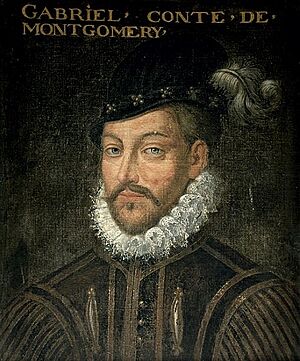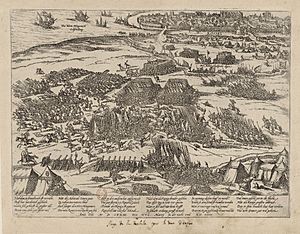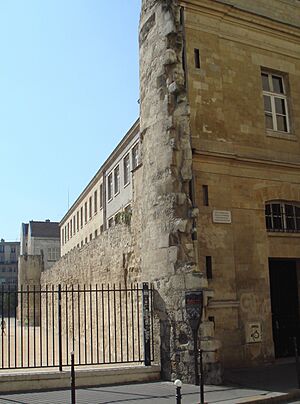Gabriel de Lorges, Count of Montgomery facts for kids
Quick facts for kids
Gabriel de Lorges
|
|
|---|---|
| Count of Montgomery Lord of Lorges and Ducey |
|
 |
|
| Born | Gabriel de Lorges 5 May 1530 Ducey, Normandy, France |
| Died | 26 June 1574 (aged 44) Place de Grève, Paris, France |
| Spouse(s) |
Isabeau de La Touche
(m. 1550) |
Gabriel de Lorges, also known as the Count of Montgomery, was a French nobleman born on May 5, 1530. He was a captain in the Scots Guard, a special group of soldiers who protected King Henry II of France. Gabriel is famous for two main reasons. First, he accidentally injured King Henry II during a jousting match, which led to the king's death. Second, he later became a Protestant and a leader of the Huguenots. Huguenots were French Protestants who faced challenges in France during that time. In French, his name is often spelled Montgommery.
Contents
Gabriel de Montgomery's Life and Role in History
The Jousting Accident
On June 30, 1559, a big celebration was held. It marked the end of a war between France and its old enemies, the Habsburgs. There were also two important weddings. King Henry II's sister, Marguerite, married the Duke of Savoy. His oldest daughter, Elisabeth, married Philip II, the King of Spain.
As part of the celebration, King Henry II took part in a jousting match. Jousting was a sport where two knights on horseback rode towards each other. They tried to break their wooden lances on the opponent's shield.
During the match, Gabriel de Montgomery's lance broke. A small piece of wood from his shattered lance flew into King Henry's eye. It went into his brain, causing a fatal injury. King Henry II died on July 10, 1559. Before he passed away, the king told Montgomery that he was not to blame.

Becoming a Huguenot Leader
Even though the king forgave him, Montgomery felt disgraced. He left the royal court and went to his family's lands in Normandy. There, he began to study religion. He soon converted to Protestantism. This made him an enemy of the state, as France was mostly Catholic at the time.
Montgomery then joined the Huguenots, who were French Protestants. He became an important leader during the French Wars of Religion. These were a series of conflicts between Catholics and Protestants in France.
Fighting in the Wars of Religion
During the First War (1562–1563), Montgomery fought for the Huguenots. He captured the city of Bourges. He also led several battles in his home region of Normandy. He helped defend the city of Rouen. He managed to escape just as the city fell to the enemy.
After the Peace of Amboise ended the fighting, Montgomery stayed in France. But the wars started again in 1567. He fought under another Huguenot leader named Condé in major battles from 1567 to 1569.
After Condé died in March 1569, Montgomery had a new mission. He was asked to help Jeanne d'Albret, the Huguenot queen of Navarre. Her lands had been taken by Catholic forces. Montgomery led a quick campaign. He destroyed a Catholic army at Orthez in August 1569.
Later, Montgomery joined forces with survivors from a big battle called Moncontour. This combined army, led by Coligny and young princes, fought the Catholics to a standstill. They managed to get a good peace agreement from the French Crown.
Escape to England and Final Return
Montgomery was one of the few Huguenot leaders to survive the St. Bartholomew's Day massacre. This was a terrible event where many Protestants were killed. A wounded Huguenot swam across the Seine River to warn him. Montgomery managed to escape to England.
The queen mother of France, Catherine de' Medici, asked Queen Elizabeth I of England to send him back. But Queen Elizabeth refused.

Montgomery returned to France with a fleet of ships in 1573. He tried to help the city of La Rochelle, which was under siege. The next year, he tried to start a rebellion in Normandy. However, he was captured and taken to Paris.
On June 26, 1574, Montgomery was sentenced to death. Just before his execution, he learned that his property would be taken away. His children would also lose their noble titles.
Montgomery in Books
Gabriel de Montgomery's life story has been told in books. Alexandre Dumas, a famous French writer, wrote a novel called The Two Dianas (1846–47) that was inspired by Montgomery's life. He also appears as a main character in a story called "Klara Mongomery" by Johann August Apel.
Family Life
In 1550, Gabriel de Montgomery married Isabeau de La Touche. She passed away in 1593. Together, they had four sons and four daughters.
Sons
- Jacques I de Montgomery (1551–1560)
- Gédéon de Montgomery (died 1596)
- Gilles de Montgomery (1558–1596)
- Gabriel II de Montgomery (1565–1635)
Daughters
- Suzanne de Montgomery
- Elisabeth de Montgomery
- Claude de Montgomery
- Roberte de Montgomery


